A Look Into the Workshop
= Requintonator™ Serial #20 ===
The first Requintonator™, #15, was such a wonderful success that it deserves to have a sibling. So this will be a 6-string, short scale, resonator guitar. It's as if a standard guitar had a capo on the 5th fret, making the tuning A, D, G, C, E, A. There's a traditional instrument with this tuning called a requinto, hence my term Requintonator™.
The optional features are:
- 6 strings; scale 19.2"
-
Wenge body with koa binding
- Herringbone and W-B-W purfling
- Round ebony-lined soundholes
-
Maple neck with sunburst stain
- Honduran rosewood fingerboard
- Curvey, paddle-shape headstock with wenge veneer
- Gold Mother of Pearl and abalone turtle inlay
Standard features include:
- Spherically arched back
- Radiused fingerboard
-
James tailpiece
- Spider bridge and resonator cone
-
Gayle design coverplate
-
Glossy nitrocellulose finish
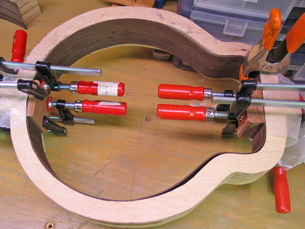
The sides are being joined with end blocks. The sides are held in a form and the end blocks are clamped in place at each end. Wax paper separates the outside of the instrument body and the form to prevent any glue seepage from joining them together.
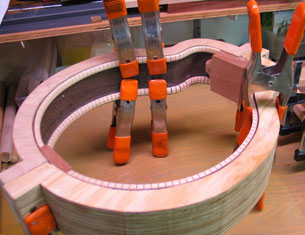
Linings have been added to the rim, and some side support struts are being glued in place.
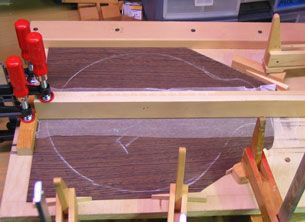
Here the two halves of the front are being joined. The wax paper isolates the clamp from any glue that might seep from the join.
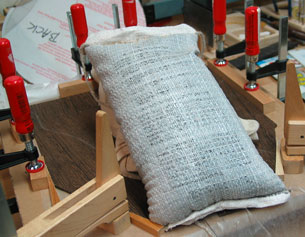
The two halves of the back are being joined. The back pieces are on a "dished" form and are weighted with sacks of gunshot. Yes, gunshot; a small sack is quite heavy and molds to different shapes. The result will be a spherically arched back.
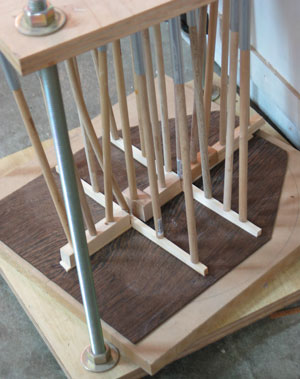 Braces are being glued on the back of the instrument using a go-bar deck, which clamps the braces to the back while the glue dries. The braces are arched to match the arch in the back and will help maintain the arch as well as strengthen the back.
Braces are being glued on the back of the instrument using a go-bar deck, which clamps the braces to the back while the glue dries. The braces are arched to match the arch in the back and will help maintain the arch as well as strengthen the back.
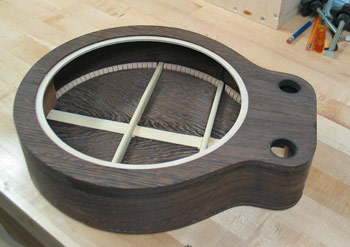 I attached the top to the rim, then cut the openings for the resonator cone and sound holes, which I lined with ebony. Then I attached the back and trimmed the top and back flush to the rim. Here the body still needs to have binding installed.
I attached the top to the rim, then cut the openings for the resonator cone and sound holes, which I lined with ebony. Then I attached the back and trimmed the top and back flush to the rim. Here the body still needs to have binding installed.
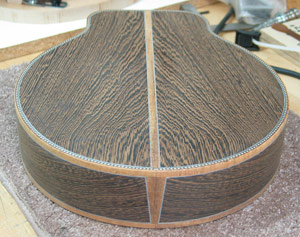 Is this pretty or what? The wonderful grain in the wenge is framed beautifully by the koa binding and matching centerline and tail wedge inlays. You can also see a hint of the herringbone purfling. Purfling, binding, and inlay are outlined by boxed W-B-W purfling.
Is this pretty or what? The wonderful grain in the wenge is framed beautifully by the koa binding and matching centerline and tail wedge inlays. You can also see a hint of the herringbone purfling. Purfling, binding, and inlay are outlined by boxed W-B-W purfling.
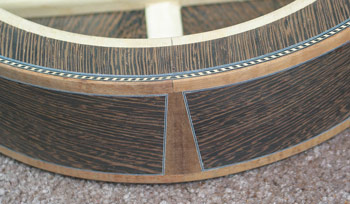 Here's a closer look at the tail, showing the W-B-W purfling which outlines the koa binding and wedge on the rim, and the herringbone purfling on the top and back of the instrument.
Here's a closer look at the tail, showing the W-B-W purfling which outlines the koa binding and wedge on the rim, and the herringbone purfling on the top and back of the instrument.
Requintonator™ 20 has been completed! You can see photos of the finished instrument on its Gallery page.